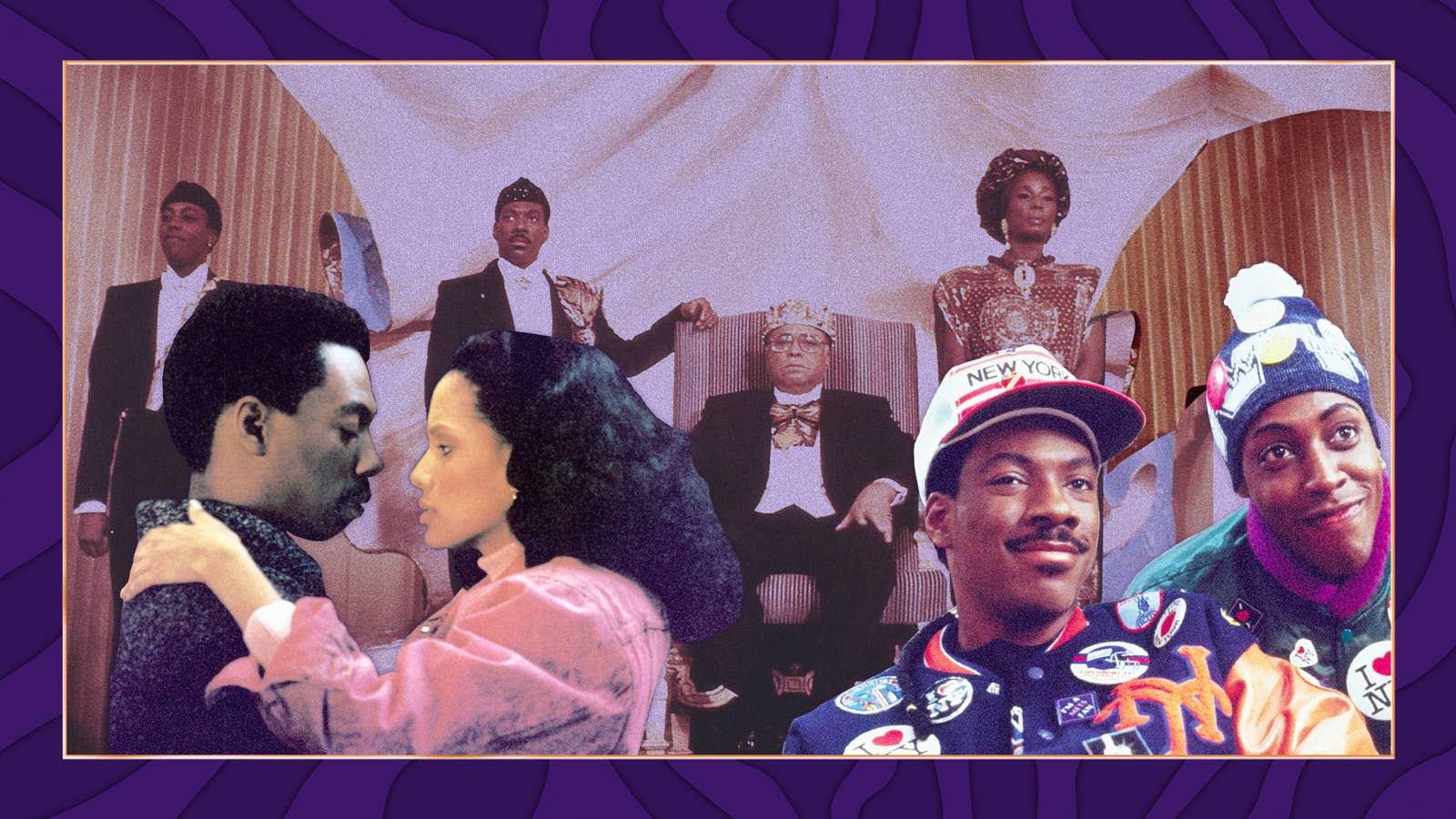
Steeped in a rich history of perseverance, diversity, and sustaining a legacy, Crown Royal embodies the same regal essence of Coming to America, a cult classic that introduced audiences to Black excellence at its finest. In anticipation of the franchise’s sequel, in partnership with Crown Royal we paired two of today’s hottest culture makers with African roots to discuss the magnitude of the original and how it gave birth to a generation of ‘New Royalty.’
In 1988, Eddie Murphy struck gold with Coming to America, a laugh-out-loud comedy about an endearing African prince named Akeem who bucked tradition on a quest to find true love in an unlikely place: Queens, New York. With a singular blend of heart and humor, the film gifted moviegoers with countless gems that became instant pop culture touchstones. The comedy would go on to become the studio’s highest-earning film that year, and Murphy would round out the decade as Hollywood’s box office king.
In the 33 years since its release, Coming to America has been passed down and grafted upon generations like the purple and gold bag that clothes your family’s favorite whisky. In fact, it’s hard to remember a time when the film wasn’t part of the zeitgeist and on everyone’s lips like a sip of Crown Royal. The story of Prince Akeem, his trusted confidant Semmi (Arsenio Hall), and his royal court continues March 5 with the release of Coming 2 America on Amazon Prime Video. Three decades in the making, it’s one of the most anticipated sequels ever. That excitement is rooted not only in seeing how the lives of these memorable characters have evolved but the cultural impact of the original, which showcased Black excellence on the big screen in a way that audiences had never seen before.
Although he was a kid at the time of the original film’s release, Nigerian-American entertainer Rotimi fondly recalls the nonstop laughter it brought to his parents. Now starring in the sequel as Pretty Idi, son of Akeem’s rival General Izzi (Wesley Snipes), he says it was “a once in a lifetime call” to pick up the mantle and appear in the new iteration. “It’s a regal sense, a royalty sense, it’s powerful for me to be a part of this franchise,” Rotimi continues. “Especially since I’m one of the few [cast members] that are actually from Africa.”
Coming to America helped change the perception many people had of Africa. The opening scene whisks viewers over verdant expanses of land and onto a palatial estate that signals opulence before the characters even speak. Similarly, cues of regality are echoed in the visual splendor of Crown Royal, which comes wrapped in a lustrous bag the color of royalty, trimmed in luxe gold braiding, and dons a crown emblem. Over the years, both the film and the premium whisky have become embedded icons that enjoy an ubiquity in urban communities and evoke familial warmth, while communicating class and nobility.
“I really think the original film was the first time Americans got to see Black wealth, and with this, you get to see Black royalty and you got to see Black luxury,” explains Dimplez, the marketing savant behind culture-shifting artists like H.E.R, YBN Nahmir, and Flo Milli. “I love that, the idea of Black luxury being the standard.”
“What made the first movie so impactful is that it’s when you're able to uplift Black culture we look like royalty… I think it's the first time we saw what Africa is and could be.” —Rotimi
Set in the fictitious African nation of Zamunda, Coming to America allowed fans to see the continent in a visually appealing way that denoted wealth, health and prosperity among the people and the land. The visual cues depicted by Prince Akeem’s family also showcased opulence. Whether it be the ridiculously long dining table where the royal family ate breakfast, the steady stream of rose petals that blanketed the young prince’s path, King Jaffe Joffer’s striking lion head sash draped across his chest, or the lush grounds where exotic animals roamed free. Coming to America offered U.S. audiences a chance to live the good life, but for Dimplez, who was born and raised in Nigeria, and Rotimi, the film represented a reflection of their culture.
Rotimi: “My dad is Yoruba and the Yoruba usually have a lot of money and are flashy. My uncle was a chief of the Nigerian Air Force… At the same time, it was so modern that I didn’t feel like I was doing anything different. I was chilling. I was watching soccer. There was no difference [between Nigeria and East Orange, NJ]. It was good also to see the wealthier side because if you have money there, you live better than in the States, low-key.”
Dimplez: “Especially in Nigeria. For the most part, we all own land. My uncle has a mansion, and that’s normal. It’s like a 12-bedroom mansion in Lagos, and on a big acre of land. Aside from the spacing and the property, gold was a big thing, too, because we wear gold, we wear jewelry, there’s a lot of opulence in that way. Fur is not something we really wear because it’s too hot (laughs).”
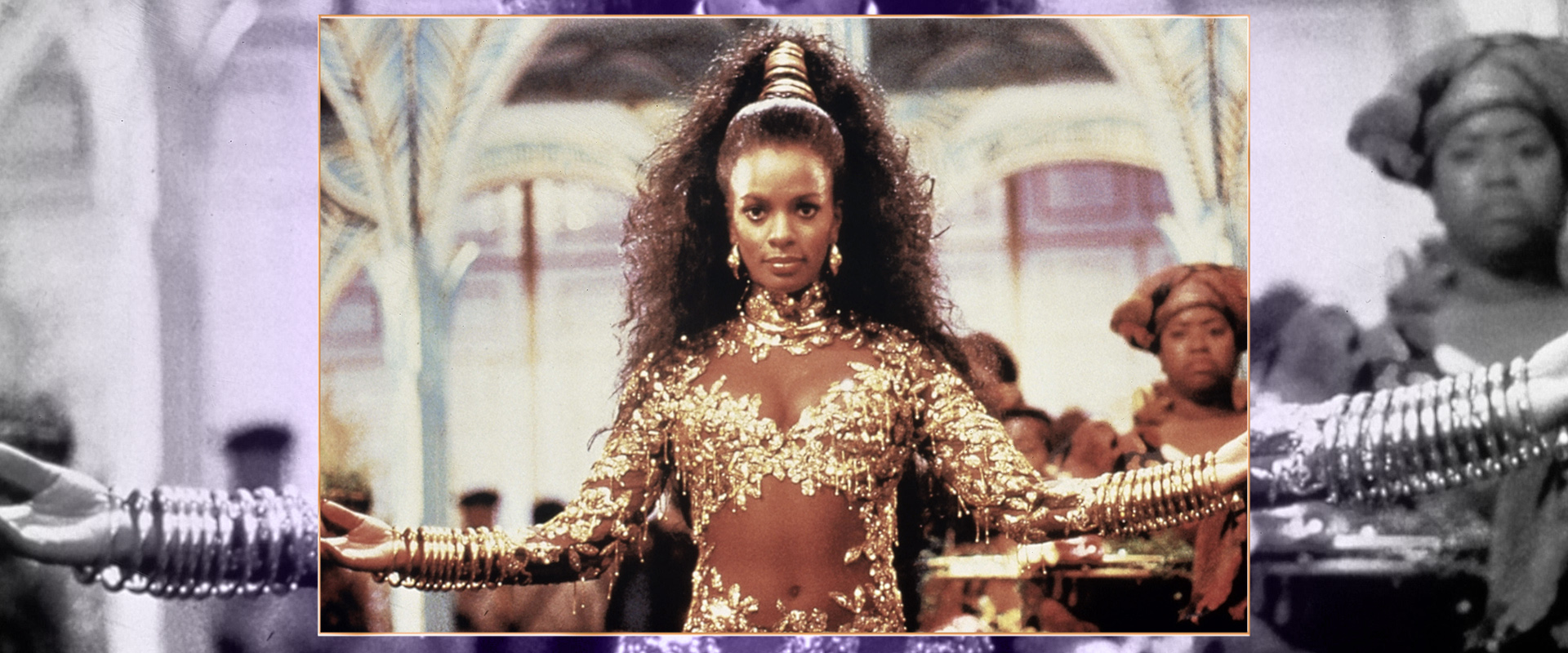
“I think it was really important to see Black opulence [in all its forms] because, as a society, we needed to understand that opulence extends on both sides.” —Dimplez
The iconic fashions featured in Coming to America are as much a part of the story as the cast itself. From the chunky gold necklaces and plush pelts draped over the shoulder to the vintage team jackets and the plaid McDowell’s uniforms, each piece played a pivotal role in pushing the narrative forward. That visual storytelling started with Prince Akeem’s stalled wedding, which was the epitome of pomp and circumstance as the nobles from neighboring African countries added to the pageantry with their opulent attire. As the ceremony began, dancers donning colorful designs and elaborate headdresses ran into the ballroom causing a brief stir before jumping into dazzling and energetic choreography that blew moviegoer’s minds.
Rotimi: “That was the first time I ever saw something like that. And then for me as a musician, the choreography behind that, how many dancers, the fashion, how everyone was in sync, the creativity at that time… You hadn’t seen anything like it.”
Dimplez: “I’m Igbo. So there’s this thing that we do called masquerade. It’s usually done around funerals and weddings. If you look it up, there’s a man in a costume on stilts, people with their hand drums, their talking drums, and all the dances that you see [in the film] are based on that. I think that’s why Coming to America is so beloved; it’s not exact, but I could see my culture in there.”
Rotimi: “I love everything that James Earl Jones (King Jaffe) wore. I think that was the epitome of strength and displaying, ‘I’m the king.’ Everything that he wore was so fly. Then Semmi had a nice little situation when he was sick of it and he was like, ‘I’m going back to who I am.’ That was another fly outfit as well.”
Dimplez: “When it comes to the fashion in the film, I think of Vanessa Bell Calloway as the bride-to-be and the gold dress she had on with the gold headpiece. Around the age of 16 I was in Arizona and I wound up doing a cotillion. Why did my mom pull out that same outfit?! [Laughs] That’s a very African thing.”
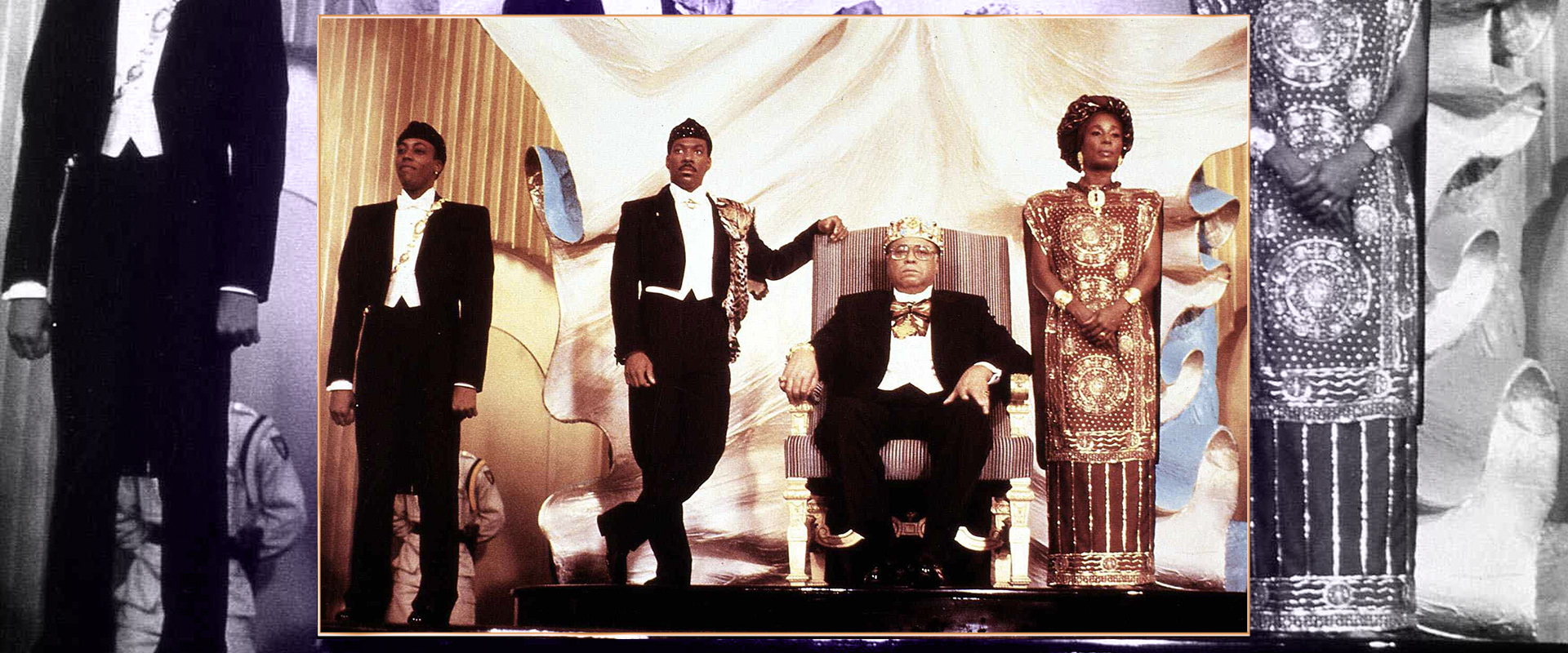
Created as a gift to King George VI and Queen Elizabeth when they became the first reigning monarchs to visit Canada, Crown Royal’s standard-bearing legacy runs deep. It’s an apt parallel to Coming to America, a film that gifted the canon of entertainment with positive depictions of Black families both foreign and domestic. While King Jaffe and his royal family represented the pinnacles of African wealth, Cleo McDowell, the enterprising single father of daughters Lisa and Patrice, showcased what success looks like for a Black middle class family from Queens.
Dimplez: “I think it was really important to see Black opulence [in all its forms] because, as a society, we needed to understand that opulence extends on both sides. There’s a lot more that connects us than there is that divides us, right?”
“Here you have two young girls being raised by their father. They’re affluent. They’re in New York. They’re living well, the family owns a business. Then you have a Black family from Africa, same thing. They’re both well off. The only thing that really divides them is cultural distinctions, but outside of that, they’re the same, right? The girls still listen to their father; they’re deferential. The prince still listens to his parents; he’s deferential. And [Lisa and Akeem] both operate with a sense of humility that allows us to join them in a story throughout the duration of the movie.”
Rotimi: “What made the first movie so impactful is that it’s when you’re able to uplift Black culture we look like royalty. I think it’s the first time that we saw what Africa is and could be, and that we had our own money, that we were royal, that we are living better than most Americans. I think that was part of the global smash.”
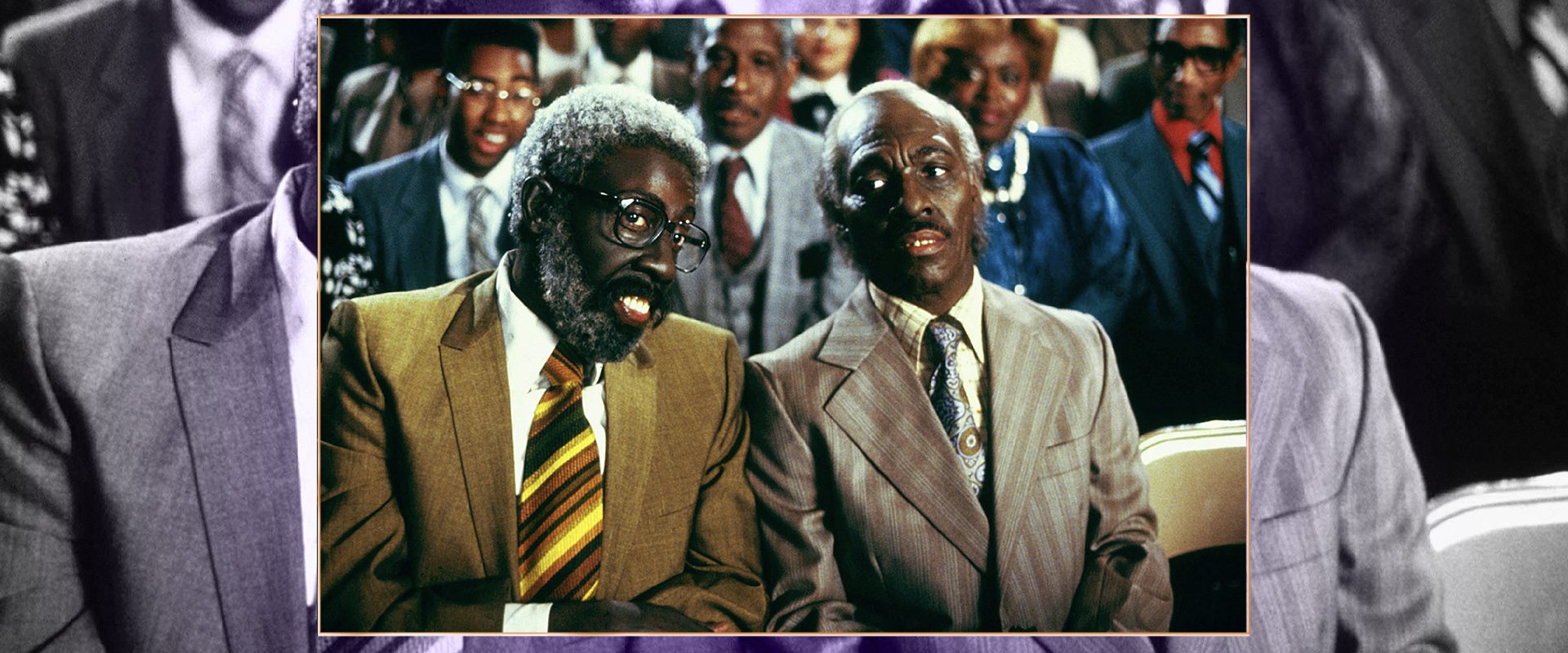
Coming to America’s groundbreaking depictions of Black excellence in all its forms is only part of the film’s lasting legacy. At its core was a timeless love story wrapped in layers of comedic gold. Spearheaded by Eddie Murphy and Arsenio Hall, who both portrayed multiple memorable characters, the entire cast delivered performances that were so funny that even 30 years later they live in people’s minds rent free. There are countless classic scenes that live on in meme form and continue to keep the laughs rolling. What Eddie and co. created with Coming to America was the perfect mix of aspirational and attainable. It set the gold standard for what Black creatives could achieve and became a cult classic in the process.
Rotimi: “How brilliantly written was this film? Eddie Murphy literally played four people, and that was the first time we’d really seen something like that, other than somebody doing it in a play. Even him playing a white Jewish guy [Saul] in the ’80s… he was taking such a cultural risk to do that.”
Dimplez: “Eddie Murphy is one of the greatest comedians of all time and he’s not just situationally funny. He’s a storyteller. So you think of the barbershop scene where he’s in character as Saul telling the joke about tasting the soup but there’s no spoon and the punchline is like, ‘aha, aha!’ I literally say that in everyday life, I’m like, ‘aha, aha!’ and the moment I say that you remember the story of the soup and that there was no spoon.”
Rotimi: “I think Coming to America made us love ourselves. It was the first, initial feeling of, ‘You know what? I want to go to Africa.’ Growing up, I remember when it wasn’t cool to be African in school. I remember when it was jokes like, ‘Oh, you off the boat…’ But when that movie came out, the questions started happening, like, ‘Yo, is Africa really like that?’ It was ignorant, but it was uplifting in its own right. The curiosity was in a positive light.”
Dimplez: “The guy that was mopping the floor at McDowell’s was the prince of a whole other nation! It’s an immigrant story that even if you aren’t Black, you can relate to that.”
Rotimi: “I think people love a good love story. Behind all of it, the core of just what love is and how you find it in random places. So the fact that Lisa was supposed to be with the fly guy with the curls and all that, but she saw past the B.S. and didn’t even know that she’s dealing with a real prince.”
“Everything was so brilliant that even kids can understand with no complexity behind it, and it’s timeless jokes that are still relevant today—from ‘Sexual Chocolate’ to all of it. Everything is still relevant. I think that it’s lightning in a bottle because I don’t know if they knew what they were doing at that time. I don’t know if they knew that they were creating a masterpiece. From top to bottom, it was something super-special.”
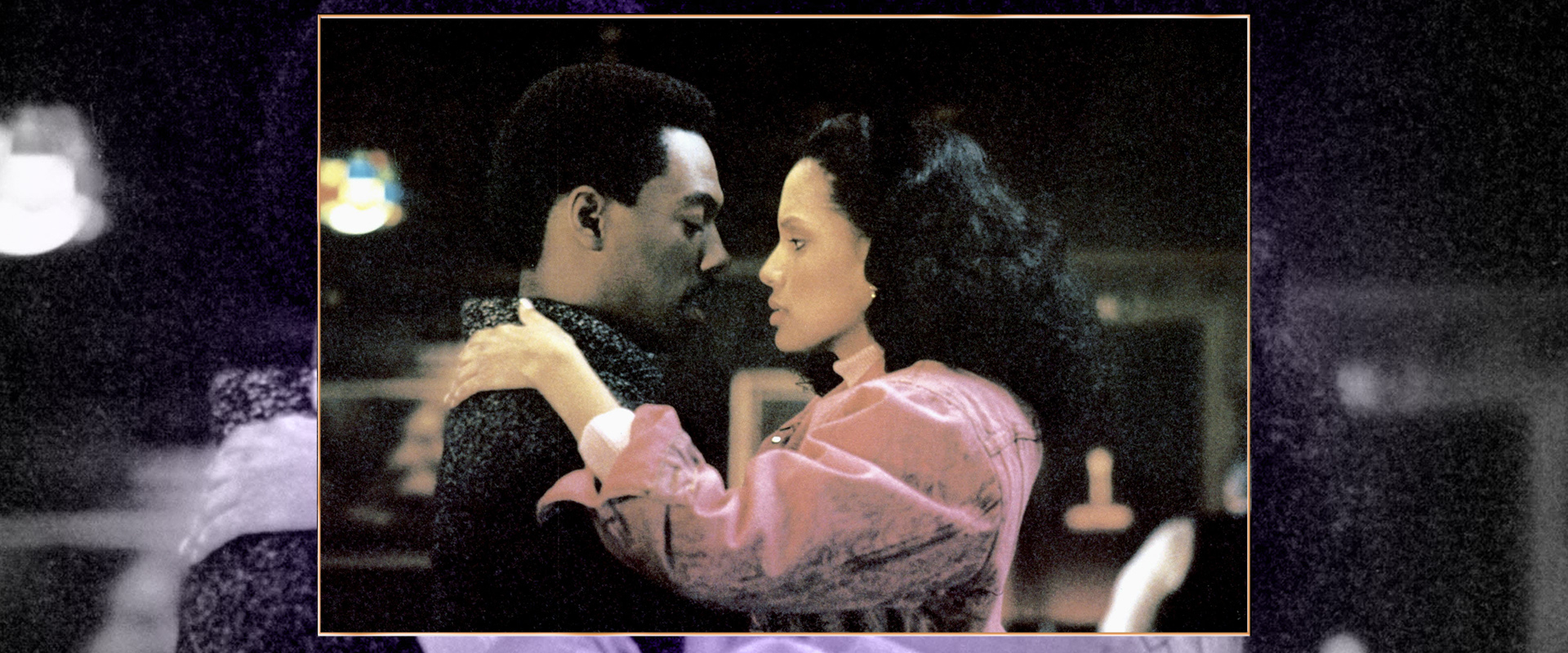
The highly-anticipated sequel, Coming 2 America, will premiereexclusively on Amazon Prime Video starting March 5. In celebration of the film’s release, Crown Royal tapped Oscar-winning Costume Designer Ruth E. Carter to create a limited-edition pack fit for a King or Queen. Check your local retailers for a bottle of this collector’s edition of Crown Royal Fine De Luxe Blended Canadian Whisky.
Please Drink Responsibly. CROWN ROYAL Blended Canadian Whisky. 40% Alc/Vol. The Crown Royal Company, New York, NY.

